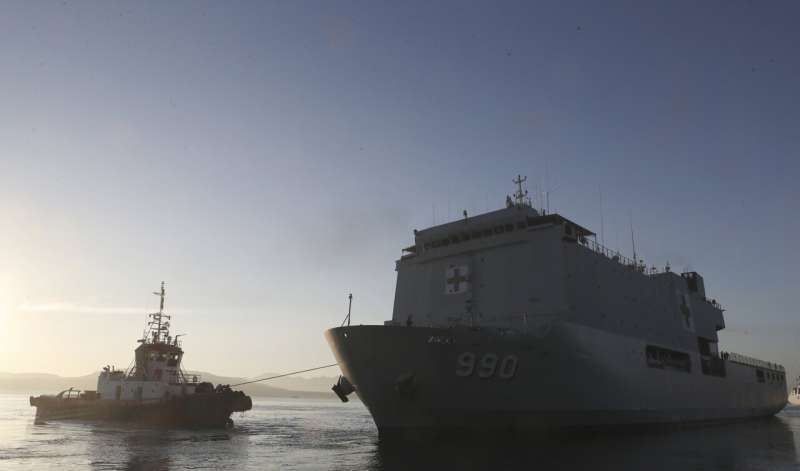This article has been reviewed according to Science X's editorial process and policies. Editors have highlighted the following attributes while ensuring the content's credibility:
fact-checked
reputable news agency
proofread
Past deep sea rescues show the challenges of saving those on board

The desperate search for a submersible that disappeared while taking five people to view the Titanic wreckage has drawn attention to other deep-sea rescues.
Those rescue efforts—from a submersible off Ireland to a submarine off the New Hampshire coast—offer some measure of hope for the passengers and their families. But some of those rescues were not as complex as the effort to find the Titan submersible. They were often in shallower waters and, in several cases, were much bigger crafts. Many ended with some, if not all, the passengers on board dying—demonstrating the inherent risk of operating in the deep ocean.
___
PISCES III SUBMERSIBLE
Fifty years ago, two British sailors sat trapped in a deep-sea submersible more than 1,500 feet below the surface of the Atlantic Ocean, facing an uncertain fate while an international team scrambled to figure out a way to free them.
In an incident that echoes the efforts to find and retrieve those trapped in the Titan submersible, Roger Chapman's and Roger Mallinson's lives hung on the success of the mission—which turned out to be the deepest known successful underwater rescue.
The operation illustrates the difficulty of carrying out deep water rescues.
The ordeal for Chapman and Mallinson began as the two were laying a transatlantic telephone cable about 150 miles (241 kilometers) off the coast of Cork, Ireland on August 29, 1973.
During what would otherwise have been a routine shift, water began flooding the aft section of the vessel, which measured only about six feet in diameter. The Pisces III would sink to about 1,575 feet (480 meters).
Once the vehicle reached the sea floor, the two could do little more than check for leaks and do their best to conserve oxygen. Unlike Titan, they were able to maintain communication with those on the surface.
The Pisces III was too deep for divers so the rescuers began searching for other options, One was a U.S. remote controlled submersible called CURV-III for Controlled Underwater Recovery Vehicle. The Canadian Coast Guard and the Royal Navy also responded. Two similar submersibles—Pisces II and Pisces V—were also dispatched to the scene.
Rescuers managed to attach cables to the stranded submersible. With available oxygen running low and the two having eaten their only food—a can of lemonade and a cheese sandwich—rescuers began to hoist the Pisces III until it broke the surface of the water.
Chapman and Mallinson had to wait a bit longer as workers struggled for 30 minutes to open the hatch and allow fresh aid to rush in.

The two had been in the capsule for more than 84 hours and had an estimated 12 minutes of oxygen left when they were able to exit the cramped quarters.
___
USS SQUALUS
Off the coast of New Hampshire, the diesel-electric submarine USS Squalus was on a test dive in March 1939 when a valve failure caused a portion of the sub to flood. The Squalus bottomed out at about 240 (73 meters) of water off the Isle of Shoals.
Rescue operations began the following day, according to the Navy History and Heritage Command. Fort the first time, the Navy used the McCann rescue chamber—a pear shaped steel chamber—that was lowered down to the sub and successfully transported surviving crew members to the surface. Over the next 13 hours, 33 surviving crew members were rescued. Twenty-six others drowned in the initial accident.
"During the emergency and the entire time we were on the bottom, all hands exhibited coolness and precision in carrying out the duties of their stations," according to testimony of one of the sub survivors Lt. W.T. Doyle. "Orders of the Commanding Officer were carried out promptly and efficiently. In spite of the low temperature and cramped quarters there were no complaints. A finer quality or higher spirited group of men, than those on the Squalus, will never be surpassed."
___
RUSSIAN MINISUB
In 2005, a Russian AS-28 mini submarine sank in the Pacific Ocean after becoming entangled in a fishing net.
The AS-28 has been sent to investigate an underwater surveillance antenna that had been entangled in nets. As it surveyed the area, the sub became stuck in about 620 feet of water.
Seven trapped sailors started writing farewell letters to loved ones as water supplies dwindled and the air thinned in the claustrophobic mini-sub on the Pacific floor. But with only several hours of oxygen to spare, a British robotic vessel was able to free the sub.
Crew members recalled three days of darkness and frigid temperatures.
"It was cold, cold, very cold. I can't even describe it," one crew member with reddish hair said as the sailors walked ashore with dazed looks and bloodshot eyes after their vessel was cut loose from cables that had snagged it.

Soon after, Russia officials investigating the near-tragedy found problems with the rescue effort. Among them were reports that the Navy may have initially refused the sub's request to be towed free, fearing damage to the underwater antenna assembly.
The response brought to mind the bungled response to the 2000 Kursk submarine disaster, in which most of the 118 members of the crew were killed instantly. As the submarine sank to the bottom of the sea, only about 350 feet (108 meters) below the surface, 23 men were able to flee to a rear compartment, where they waited for help. But delays in launching a rescue effort and then seeking Western help doomed the remaining crew who mainly died of suffocation.
___
INDONESIAN SUB
Two years ago, an Indonesian submarine disappeared off the resort island of Bali with 53 sailors aboard.
The submarine lost contact after being granted clearance to dive. The Defense Ministry said a helicopter later spotted an oil slick near the dive's starting position.
The Navy launched a frantic search and predicted the sub would run out of oxygen in the next several days. An underwater robot equipped with cameras found the lost submarine lying in at least three pieces on the ocean floor at a depth of 838 meters (2,750 feet). All 53 crew members died.
The cause of the German-built diesel-powered submarine sinking remains uncertain. The Navy previously said an electrical failure could have left the submarine unable to execute emergency procedures to resurface. Emergency survival suits that are normally kept in boxes were found floating underwater, apparently indicating the crew may have tried to put them on during the emergency.
———
USS THRESHER
In 1963, the crew of a rescue ship listened helplessly after receiving an ominous message "exceeding test depth" before the nuclear-powered USS Thresher disintegrated under the crushing pressure of the sea in 1963. Killed were 129 sailors and civilians on a routine test dive off Cape Cod.
There was a massive search by air and surface forces using sonar, magnetometers and radiation detectors. Some floating debris was recovered. But it wasn't until several months later that a deep-diving research bathyscaphe discovered the wreckage at a depth of about 8,500 feet.
The sub's remnants cover a mile of ocean floor at a depth of 8,500 feet (2,590 meters), according to oceanographer Robert Ballard, who used his 1985 discovery of RMS Titanic as a Cold War cover for the fact that he had surveyed the Thresher on the same mission.
© 2023 The Associated Press. All rights reserved. This material may not be published, broadcast, rewritten or redistributed without permission.





















